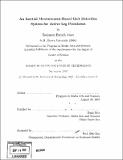| dc.contributor.advisor | Hugh Herr. | en_US |
| dc.contributor.author | Aisen, Benjamin Baruch | en_US |
| dc.contributor.other | Massachusetts Institute of Technology. Dept. of Architecture. Program in Media Arts and Sciences. | en_US |
| dc.date.accessioned | 2008-05-19T16:13:55Z | |
| dc.date.available | 2008-05-19T16:13:55Z | |
| dc.date.copyright | 2007 | en_US |
| dc.date.issued | 2007 | en_US |
| dc.identifier.uri | http://hdl.handle.net/1721.1/41744 | |
| dc.description | Thesis (S.M.)--Massachusetts Institute of Technology, School of Architecture and Planning, Program in Media Arts and Sciences, 2007. | en_US |
| dc.description | Includes bibliographical references (leaves 45-46). | en_US |
| dc.description.abstract | Active leg prostheses can lead to more natural and less energy consuming gait patterns for amputees than passive prostheses can, because they provide a better approximation of the functions of the human leg. Active prostheses use motors to supply torques for added force and greater control at the joints (replacing the functions of normal limb musculature). The necessary amount of torque to apply must be closely correlated with gait characteristics. To properly control an active prosthesis, it is necessary to determine whether one is walking at a stable or varying velocity, on level ground, stairs, or a hill or ramp, and in the latter cases whether one is ascending or descending. In all cases, it is essential to detect transitions between gaits as early as possible, ideally before the foot makes contact with the ground, in order for the control system to adjust accordingly. In this thesis, a sensor system for a lower leg prosthesis is described, and a method for determining the gait transitions from this system are presented. The sensor system consists of an inertial measurement unit comprising three accelerometers and three rate gyroscopes installed on the prosthetic limb and a set of strain gauges on the limb to detect changes in force. Using this instrumented prosthesis, data are collected while an amputee participant transitions from level ground to stair ascent/descent. These data are then processed using an intent recognition method based on a hybrid discrete-continuous physical model of human walking. This method is evaluated for accuracy and robustness for real-time use. | en_US |
| dc.description.statementofresponsibility | by Benjamin Baruch Aisen. | en_US |
| dc.format.extent | 46 leaves | en_US |
| dc.language.iso | eng | en_US |
| dc.publisher | Massachusetts Institute of Technology | en_US |
| dc.rights | M.I.T. theses are protected by
copyright. They may be viewed from this source for any purpose, but
reproduction or distribution in any format is prohibited without written
permission. See provided URL for inquiries about permission. | en_US |
| dc.rights.uri | http://dspace.mit.edu/handle/1721.1/7582 | en_US |
| dc.subject | Architecture. Program in Media Arts and Sciences. | en_US |
| dc.title | An inertial measurement-based gait detection system for active leg prostheses | en_US |
| dc.type | Thesis | en_US |
| dc.description.degree | S.M. | en_US |
| dc.contributor.department | Program in Media Arts and Sciences (Massachusetts Institute of Technology) | |
| dc.identifier.oclc | 225884264 | en_US |
